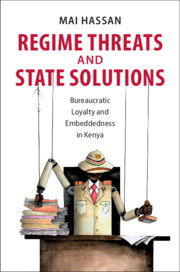Regime Threats and State Solutions
Post developed by Katherine Pearson and Mai Hassan.
States can exert powerful social control over citizens. In her newly-published book, Regime Threats and State Solutions, Mai Hassan demonstrates how leaders use their authority to manage bureaucrats to advance their policy and political goals.
By controlling which bureaucrats are hired, where they’re posted, how long they stay in a post, and who gets fired or promoted, leaders can induce the bureaucratic behaviors that will help keep them in power.
Focusing on Kenya since independence, Hassan uses qualitative and quantitative data gleaned from archival records and interviews to show how the country’s different leaders have strategically managed the public sector. The data show that the strategic management of bureaucrats existed under the one-party authoritarian regime beginning with Kenya’s independence in 1963, and continued after Kenya’s transition to an electoral regime in 1991. Under both regime types, leaders were able to co-opt societal groups that are needed for support and coerce the groups most likely to challenge the regime.
Haasan examines how leaders rely on bureaucrats to manage popular threats against the leader such as protests and strikes. First, she argues that leaders assign bureaucrats with deep social bonds to those areas where the leader needs to co-opt the local population. These deep social bonds compel bureaucrats to work on behalf of the area. But in areas that need more coercion, the leader tends to prevent the posting of bureaucrats with deep local roots because those who have deep roots will be unwilling to coerce locals.
Second, she finds that the parts of the country that are most strategically important for the leader — and thus, the areas of the country where bureaucratic compliance is needed most — are staffed by the most loyal bureaucrats, those who are most willing to help keep the leader in office. Leaders can also neutralize the risks of disloyal bureaucrats by carefully managing where potentially disloyal officers are posted and how long they stay in their posts.
Why would a leader hire or promote disloyal bureaucrats in the first place? Hassan addresses this question by showing that most state bureaucracies are not actually packed with the leader’s in-group members, who tend to be the most loyal. Elite threats, such as coups, tend to be more pressing than popular ones. Leaders can appease rival elites by hiring and promoting bureaucrats who are loyal to elites other than the leader. Strategically posting and shuffling bureaucrats allows the leader to recruit potentially disloyal bureaucrats in order to temper elite threats, while still relying on loyal bureaucrats to prevent popular threats where they are most likely to emerge.
Overall, Hassan’s analysis shows how even states categorized as weak have proven capable of helping their leader stay in power. Her work demonstrates how the strategic management of bureaucrats solves both elite and popular threats, and in doing so, highlights why bureaucrats must be taken seriously. States may assert power, but states do not act: bureaucrats do.


